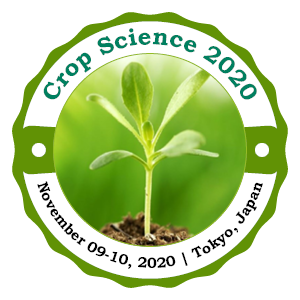Call for Abstract
Scientific Program
World Congress on Crop Science Management and Harvesting, will be organized around the theme “”
Crop Science 2020 is comprised of keynote and speakers sessions on latest cutting edge research designed to offer comprehensive global discussions that address current issues in Crop Science 2020
Submit your abstract to any of the mentioned tracks.
Register now for the conference by choosing an appropriate package suitable to you.
- Track 1-1Crop yield
- Track 1-2Soil fertility
- Track 1-3Seasonal soil rotation
- Track 1-4Agronomic crops
- Track 1-5Physiological diseases
- Track 2-1Manual harvesting
- Track 2-2Food harvesting
- Track 3-1Removal of weeds
- Track 3-2Pesticides
- Track 4-1Naturally maintaining soil fertility
- Track 4-2Nomadic herding
- Track 5-1Cover crop
- Track 5-2Global food demand
- Track 6-1Genomic research
\r\n Crop Morphology is the branch of science deals with the study of structure of structure of plant cells and tissues, morphology is the study of outer form. Difference between the plant cells and animal cells is plant cells may composed of cell wall, polysaccharides such as hemicellulose, cellulose, pectin. Plastids contain lipids, starch. Different types of vascular plants such as gymosphosres, ferns and angiosperms may have subterranean subsystems and aerial systems.Non-vascular plants such as horn plants, liverworts and mosses do not produce ground penetrating vascularizing roots as they may undergo photosynthesis.
\r\n- \r\n
- \r\n Vegetative propagation \r\n
- \r\n Plant evolution \r\n
- \r\n Non-vascular plants \r\n
- Track 7-1Reshaping plant biology
- Track 7-2Evolution of plants
- Track 7-3Ecophysiology
\r\n Crop nano technology involves complex processes in signal transduction mechanisms and in the regulation of DNA expression. Towards, it shows main role in antioxidant process for agriculture and and botanical sciences and their main aim at analysis of plant metabolomics. The increasing part of application of nanoparticles represented in smart delivery systems, promoting noble prize supports for components of magic bullets. Nanotechnology play an very important role in the agriculture, pesticides which will acts as a chemical delivery agents that targets the cellular organelles in plants.
\r\n- \r\n
- \r\n Medicinal plant nanotechnology \r\n
- \r\n Nanotechnology applications in plant pathology \r\n
- Track 8-1Medicinal plant nanotechnology
- Track 8-2Agrochemicals
\r\n Plant ecology deals with functional relationship between plants and their habitant where they complete their lifecycles. It includes the study of biodiversity, genetic diversity, regional floras and interaction with the environment .Plant growth and development changes based on the proxy temperature, historical climate conditions, global warming. Reduced Ozone layer such as exposure to the higher levels of UV-B rays results in decreased growth rate. Understanding of the plant ecology is important for vegetation changes, habitat distribution changes and species extinction, taxonomy studies.
\r\n- \r\n
- \r\n Genetic diversity \r\n
- \r\n Ecosystem Biodiversitry \r\n
- Track 9-1Mutualism
- Track 9-2Plant reproduction
\r\n Plant photoperiodism is the physiological reaction of plants to the relative lenths of light. It should be divided as the long-day plants and short day plants and day neutral plants. Long day plants mostly grow in the late spring or early summer. Short-day plants flower when the length of the night exceeds their photoperiod. New Genetic Engineering Techniques or breeding techniques will enhance the development of new trials in plant breeding. New breeding techniques involved in the changes in one or two genome DNA base sequencing. Different methods involved are Modifying and editing the genome during the repair process, transferring a gene from an identical species, adding a set of regulatory instructions from the same species and unaltered plant grafting onto a genetically modified stem plant, changing of base-pairs in a genome.
\r\n- \r\n
- \r\n Modern Plant Breeding Techniques \r\n
- \r\n Plant breeding in organic agriculture \r\n
- Track 10-1Hybridization
- Track 10-2Polyploidy
\r\n Crop pathology is defined as the study of causative agents and environmental conditions that cause disease in plants. Different types of organisms that causes infection to the plants may include fungi ,bacteria, virus, protozoa. Control of plant disease is important for the production of food .Devasting plant disease such as chestnut blight and Irish potato famine, soyabean nematode and citrus canker. Disease control is achieved by the usage of crop-rotation methods, pathogen-free and control of field moisture and also with the usage of pesticides.
\r\n- \r\n
- \r\n Physiological plant disorders \r\n
- \r\n Nematodes and Parasitic plant \r\n
- \r\n Bacteria and Fungal Plant pathogens \r\n
- Track 11-1Hereditary diseases
- Track 11-2Control of plant diseases
- Track 11-3Disease cycle
- Track 11-4Disease cycle
- Track 11-5Disease cycle
- Track 11-6Disease cycle
\r\n Plant cell wall is used specifically in the form of paper, textiles, fibers (cotton, flax, hemp, and others), charcoal, lumber, and other wood products. And also other major use of plant cell walls is in the form of extracted polysaccharides that have been modified to make plastics, films, coatings, adhesives, gels, and thickeners in a huge variety of products.
\r\n- \r\n
- \r\n Aromatic crops \r\n
- \r\n Horticultural crop \r\n
\r\n Pest management is the regulation of species which adversely shows impact on the human activities. Human response depends mainly on the range of tolerance through the deterrence, management to eradicate the pest. Pest control will be done based on the type of damage to the plant. Pests are divided as the cultural, biological and chemical forms. It should be achieved by applying the insecticides which are resistant to pests.
\r\n- \r\n
- \r\n Preventive cultural practices \r\n
- \r\n Mechanical controls \r\n
- \r\n Biological controls \r\n
<span style="\"color:" rgb(51,="" 51,="" 51);="" font-family:="" "helvetica="" neue",="" helvetica,="" arial,="" sans-serif;="" font-size:="" 14px;="" text-align:="" justify;="" background-color:="" rgb(255,="" 255,="" 255);\"="">It is a branch of science deals with the study of vegetables and fruits. It may be devided as Pomology and olericulture. Olericultutre confines with the cultivation of vegitable plants. Pomology confines with the study of ornamental plants and flowers. Horticulture mainly focuses on the green house and floriculture management, cultivation of plants.

